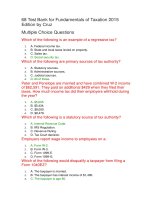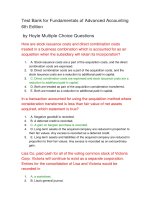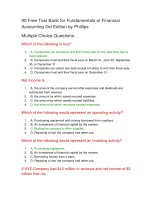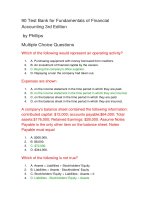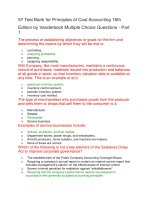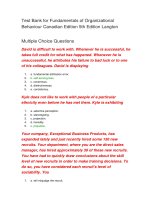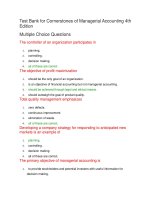Test bank for fundamentals of advanced accounting 6th edition
Bạn đang xem bản rút gọn của tài liệu. Xem và tải ngay bản đầy đủ của tài liệu tại đây (44.31 KB, 13 trang )
Test Bank for Fundamentals of Advanced Accounting
6th Edition
by Hoyle Multiple Choice Questions
How are stock issuance costs and direct combination costs
treated in a business combination which is accounted for as an
acquisition when the subsidiary will retain its incorporation?
1.
2.
3.
4.
5.
A. Stock issuance costs are a part of the acquisition costs, and the direct
combination costs are expensed.
B. Direct combination costs are a part of the acquisition costs, and the
stock issuance costs are a reduction to additional paid-in capital.
C. Direct combination costs are expensed and stock issuance costs are a
reduction to additional paid-in capital.
D. Both are treated as part of the acquisition consideration transferred.
E. Both are treated as a reduction to additional paid-in capital.
In a transaction accounted for using the acquisition method where
consideration transferred is less than fair value of net assets
acquired, which statement is true?
1.
2.
3.
4.
A. Negative goodwill is recorded.
B. A deferred credit is recorded.
C. A gain on bargain purchase is recorded.
D. Long-term assets of the acquired company are reduced in proportion to
their fair values. Any excess is recorded as a deferred credit.
5. E. Long-term assets and liabilities of the acquired company are reduced in
proportion to their fair values. Any excess is recorded as an extraordinary
gain.
Lisa Co. paid cash for all of the voting common stock of Victoria
Corp. Victoria will continue to exist as a separate corporation.
Entries for the consolidation of Lisa and Victoria would be
recorded in
1.
2.
3.
4.
5.
A. a worksheet.
B. Lisa's general journal.
C. Victoria's general journal.
D. Victoria's secret consolidation journal.
E. the general journals of both companies.
Prior to being united in a business combination, Botkins Inc. and
Volkerson Corp. had the following stockholders' equity figures:
Common stock ($1 par value): $220,000 (Botkins), $54,000
(Volkerson). Additional paid-in capital: 110,000 (Botkins), 25,000
(Volkerson). Retained earnings: 360,000 (Botkins), 130,000
(Volkerson). Botkins issued 56,000 new shares of its common
stock valued at $3.25 per share for all of the outstanding stock of
Volkerson. Assume that Botkins acquired Volkerson on January 1,
2012.
1.
2.
3.
4.
5.
A. $456,000.
B. $402,000.
C. $274,000.
D. $276,000.
E. $330,000.
Acquired in-process research and development is considered as
1.
2.
3.
4.
5.
A. a definite-lived asset subject to amortization.
B. a definite-lived asset subject to testing for impairment.
C. an indefinite-lived asset subject to amortization.
D. an indefinite-lived asset subject to testing for impairment.
E. a research and development expense at the date of acquisition.
In a transaction accounted for using the acquisition method where
consideration transferred exceeds book value of the acquired
company, which statement is true for the acquiring company with
regard to its investment?
1.
A. Net assets of the acquired company are revalued to their fair values and
any excess of consideration transferred over fair value of net assets
acquired is allocated to goodwill.
2. B. Net assets of the acquired company are maintained at book value and
any excess of consideration transferred over book value of net assets
acquired is allocated to goodwill.
3. C. Acquired assets are revalued to their fair values. Acquired liabilities are
maintained at book values. Any excess is allocated to goodwill.
4. D. Acquired long-term assets are revalued to their fair values. Any excess is
allocated to goodwill.
Which one of the following is a characteristic of a business
combination accounted for as an acquisition?
1.
2.
A. The combination must involve the exchange of equity securities only.
B. The transaction establishes an acquisition fair value basis for the
company being acquired.
3. C. The two companies may be about the same size, and it is difficult to
determine the acquired company and the acquiring company.
4. D. The transaction may be considered to be the uniting of the ownership
interests of the companies involved.
5. E. The acquired subsidiary must be smaller in size than the acquiring
parent.
At the date of an acquisition which is not a bargain purchase, the
acquisition method
1.
2.
3.
4.
5.
A. consolidates the subsidiary's assets at fair value and the liabilities at
book value.
B. consolidates all subsidiary assets and liabilities at book value.
C. consolidates all subsidiary assets and liabilities at fair value.
D. consolidates current assets and liabilities at book value, long-term
assets and liabilities at fair value.
E. consolidates the subsidiary's assets at book value and the liabilities at
fair value.
Direct combination costs and stock issuance costs are often
incurred in the process of making a controlling investment in
another company. How should those costs be accounted for in a
pre-2009 purchase transaction?
1.
2.
3.
4.
5.
A. Direct combination costs: Increase investment; Stock insurance costs:
decrease investment
B. Direct combination costs: Increase investment; Stock insurance costs:
decrease paid-in capital
C. Direct combination costs: Increase investment; Stock insurance costs:
increase expenses
D. Direct combination costs: Decrease paid-in capital; Stock insurance
costs: increase investment
E. Direct combination costs: Increase expenses; Stock insurance costs:
decrease investment
Using the acquisition method for a business combination, goodwill
is generally defined as:
1.
2.
3.
4.
5.
A. Cost of the investment less the subsidiary's book value at the beginning
of the year.
B. Cost of the investment less the subsidiary's book value at the acquisition
date.
C. Cost of the investment less the subsidiary's fair value at the beginning of
the year.
D. Cost of the investment less the subsidiary's fair value at acquisition date.
E. is no longer allowed under federal law.
Which of the following statements is true?
1.
A. The pooling of interests for business combinations is an alternative to the
acquisition method.
2. B. The purchase method for business combinations is an alternative to the
acquisition method.
3. C. Neither the purchase method nor the pooling of interests method is
allowed for new business combinations.
4.
D. Any previous business combination originally accounted for under
purchase or pooling of interests accounting method will now be accounted
for under the acquisition method of accounting for business combinations.
5. E. Companies previously using the purchase or pooling of interests
accounting method must report a change in accounting principle when
consolidating those subsidiaries with new acquisition combinations.
Which of the following statements is true regarding a statutory
merger?
1.
2.
3.
4.
5.
A. The original companies dissolve while remaining as separate divisions of
a newly created company.
B. Both companies remain in existence as legal corporations with one
corporation now a subsidiary of the acquiring company.
C. The acquired company dissolves as a separate corporation and
becomes a division of the acquiring company.
D. The acquiring company acquires the stock of the acquired company as
an investment.
E. A statutory merger is no longer a legal option.
How are direct and indirect costs accounted for when applying the
acquisition method for a business combination?
1.
2.
A. Direct costs: Expensed; Indirect costs: Expensed
B. Direct costs: Increase investment account; Indirect costs: Decrease
additional paid-in capital
3. C. Direct costs: Expensed; Indirect costs: Decrease additional paid-in
capital
4. D. Direct costs: Increase investment account; Indirect costs: Expensed
5. E. Direct costs: Increase investment account; Indirect costs: Increase
investment account
Which of the following is a not a reason for a business
combination to take place?
1.
2.
A. Cost savings through elimination of duplicate facilities.
B. Quick entry for new and existing products into domestic and foreign
markets.
3. C. Diversification of business risk.
4. D. Vertical integration.
5. E. Increase in stock price of the acquired company.
Prior to being united in a business combination, Botkins Inc. and
Volkerson Corp. had the following stockholders' equity figures:
Common stock ($1 par value): $220,000 (Botkins), $54,000
(Volkerson). Additional paid-in capital: 110,000 (Botkins), 25,000
(Volkerson). Retained earnings: 360,000 (Botkins), 130,000
(Volkerson). Botkins issued 56,000 new shares of its common
stock valued at $3.25 per share for all of the outstanding stock of
Volkerson. Assume that Botkins acquired Volkerson on January 1,
2012.
1.
2.
3.
4.
5.
A. $56,000.
B. $182,000.
C. $209,000.
D. $261,000.
E. $312,000.
According to GAAP, the pooling of interest method for business
combinations
1.
2.
3.
4.
A. Is preferred to the purchase method.
B. Is allowed for all new acquisitions.
C. Is no longer allowed for business combinations after June 30, 2001.
D. Is no longer allowed for business combinations after December 31,
2001.
5. E. Is only allowed for large corporate mergers like Exxon and Mobil.
Which one of the following is a characteristic of a business
combination that is accounted for as an acquisition?
1.
2.
3.
4.
5.
A. Fair value only for items received by the acquirer can enter into the
determination of the acquirer's accounting valuation of the acquired
company.
B. Fair value only for the consideration transferred by the acquirer can enter
into the determination of the acquirer's accounting valuation of the acquired
company.
C. Fair value for the consideration transferred by the acquirer as well as the
fair value of items received by the acquirer can enter into the determination
of the acquirer's accounting valuation of the acquired company.
D. Fair value for only consideration transferred and identifiable assets
received by the acquirer can enter into the determination of the acquirer's
accounting valuation of the acquired company.
E. Only fair value of identifiable assets received enters into the
determination of the acquirer's accounting valuation of the acquired
company.
In an acquisition where control is achieved, how would the land
accounts of the parent and the land accounts of the subsidiary be
combined?
1.
2.
3.
4.
5.
A. Parent: Book value, Subsidiary: Book value
B. Parent: Book value, Subsidiary: Fair value
C. Parent: Fair value, Subsidiary: Fair value
D. Parent: Fair value, Subsidiary: Book value
E. Parent: Cost, Subsidiary: Cost
Chapel Hill Company had common stock of $350,000 and
retained earnings of $490,000. Blue Town Inc. had common stock
of $700,000 and retained earnings of $980,000. On January 1,
2013, Blue Town issued 34,000 shares of common stock with a
$12 par value and a $35 fair value for all of Chapel Hill
Company's outstanding common stock. This combination was
accounted for as an acquisition. Immediately after the
combination, what was the total consolidated net assets?
1.
2.
3.
4.
5.
A. $2,520,000.
B. $1,190,000.
C. $1,680,000.
D. $2,870,000.
E. $2,030,000.
A statutory merger is a(n)
1.
2.
3.
4.
5.
A. business combination in which only one of the two companies continues
to exist as a legal corporation.
B. business combination in which both companies continue to exist.
C. acquisition of a competitor.
D. acquisition of a supplier or a customer.
E. legal proposal to acquire outstanding shares of the target's stock.
An example of a difference in types of business combination is:
1.
2.
3.
4.
5.
A. A statutory merger can only be effected by an asset acquisition while a
statutory consolidation can only be effected by a capital stock acquisition.
B. A statutory merger can only be effected by a capital stock acquisition
while a statutory consolidation can only be effected by an asset acquisition.
C. A statutory merger requires dissolution of the acquired company while a
statutory consolidation does not require dissolution.
D. A statutory consolidation requires dissolution of the acquired company
while a statutory merger does not require dissolution.
E. Both a statutory merger and a statutory consolidation can only be
effected by an asset acquisition but only a statutory consolidation requires
dissolution of the acquired company.
What is the primary accounting difference between accounting for
when the subsidiary is dissolved and when the subsidiary retains
its incorporation?
1.
A. If the subsidiary is dissolved, it will not be operated as a separate
division.
2. B. If the subsidiary is dissolved, assets and liabilities are consolidated at
their book values.
3. C. If the subsidiary retains its incorporation, there will be no goodwill
associated with the acquisition.
4.
D. If the subsidiary retains its incorporation, assets and liabilities are
consolidated at their book values.
5. E. If the subsidiary retains its incorporation, the consolidation is not formally
recorded in the accounting records of the acquiring company.
Which of the following statements is true regarding the acquisition
method of accounting for a business combination?
1.
2.
3.
A. Net assets of the acquired company are reported at their fair values.
B. Net assets of the acquired company are reported at their book values.
C. Any goodwill associated with the acquisition is reported as a
development cost.
4. D. The acquisition can only be effected by a mutual exchange of voting
common stock.
5. E. Indirect costs of the combination reduce additional paid-in capital.
Which of the following statements is true regarding a statutory
consolidation?
1.
2.
3.
4.
5.
A. The original companies dissolve while remaining as separate divisions of
a newly created company.
B. Both companies remain in existence as legal corporations with one
corporation now a subsidiary of the acquiring company.
C. The acquired company dissolves as a separate corporation and
becomes a division of the acquiring company.
D. The acquiring company acquires the stock of the acquired company as
an investment.
E. A statutory consolidation is no longer a legal option.
34 Free Test Bank for College Accounting 14th Edition
by Price Multiple Choice Questions
Owners and managers need financial information in order to
1.
2.
3.
4.
A. grant loans.
B. issue credit.
C. collect taxes.
D. make decisions.
The Financial Accounting Standards Board is responsible for
1.
2.
3.
4.
A. auditing financial statements.
B. developing generally accepted accounting principles.
C. establishing accounting systems for businesses.
D. making recommendations to the Securities and Exchange Commission.
The review of financial statements to assess their fairness and
adherence to GAAP is
1.
A. accounting.
2.
3.
4.
B. preparation.
C. compliance.
D. auditing.
Tax accounting involves tax compliance and
1.
2.
3.
4.
A. tax evaluation.
B. tax planning.
C. tax configuration.
D. tax obfuscation.
The form of a business organization that is not affected by the
withdrawal or death of an owner and can continue forever is
1.
2.
3.
4.
A. the sole proprietorship.
B. the partnership.
C. the corporation.
D. the nonprofit organization.
Management advisory services are designed to help
1.
2.
3.
4.
A. government agencies.
B. clients.
C. employers.
D. creditors.
Identify the statement below that represents what GAAP stands
for
1.
2.
3.
4.
A. Generally Accepted Accounting Principles.
B. Generally Accepted Auditing Practices.
C. General Accounting Actuary Principles.
D. Generally Approved Accounting Practices.
Which of the following is NOT an area in which accountants
usually practice?
1.
2.
3.
4.
A. Public Accounting
B. Industrial Accounting
C. Governmental Accounting
D. Managerial (Private) Accounting
Tax planning includes
1.
2.
3.
4.
A. preparing tax returns.
B. auditing tax returns.
C. correcting tax returns.
D. suggesting actions to reduce tax liability.
Which of the following is NOT a type of information communicated
by the financial statements?
1.
2.
3.
4.
A. the equity, or value, of the business
B. the amount spent on costs (expenses) of the business
C. the types of products and services the business provides
D. the amount of revenue earned by the business
The Sarbanes-Oxley Act includes rules on
1.
2.
3.
4.
A. auditor retention.
B. auditor reliability.
C. auditor rotation.
D. auditor reporting.
The area of accounting that involves the preparation of internal
reports for a firm's executives and the analysis of the data in
these reports to aid in decision making is known as
1.
2.
3.
4.
A. financial accounting.
B. managerial accounting.
C. auditing.
D. cost accounting.
An example of an economic entity is
1.
2.
3.
4.
A. a town.
B. a business.
C. a politician.
D. a church.
An independent accountant who provides accounting services to
the public for a fee is a
1.
2.
3.
4.
A. CIA.
B. CFE.
C. CMA.
D. CPA.
A firm issues periodic reports called
1.
2.
3.
4.
A. financial statements.
B. summaries.
C. tax returns.
D. audits.
Identify the form of business that is considered a separate legal
entity.
1.
2.
3.
4.
A. a sole proprietorship
B. a corporation
C. a limited liability partnership
D. a partnership
Identify the advantages of forming a business as an S
Corporation.
1.
2.
3.
4.
A. owners avoid double taxation and owners have limited liability
B. treated as a separate legal entity and owners avoid double taxation
C. owners have limited liability and corporation's earnings are tax free
D. owner is personally responsible for debts of the business and earnings
are reported
5. directly on owner's personal tax return
Identify which of the following are considered OUTSIDE users of
financial accounting information.
1.
2.
3.
4.
A. employees
B. managers
C. owners
D. banks
The financial affairs of a business and the financial affairs of the
owners should be
1.
2.
3.
4.
A. combined in the firm's accounting records.
B. reported in different parts of the firm's accounting records.
C. combined only if the owner wants them to be.
D. kept totally separate.
All financial statements submitted to the SEC by publicly owned
corporations must include an auditor's report prepared by
1.
2.
3.
4.
A. an internal auditor.
B. the firm's managerial accountant.
C. an independent certified public accountant.
D. anyone in the accounting department.
Which of the following is NOT part of the process of accounting
for financial information?
1.
2.
3.
4.
A. recording
B. identifying
C. communicating
D. classifying
An act passed in response to the wave of corporate accounting
scandals is the
1.
2.
3.
4.
A. Saxon-Ordanly Act.
B. Sarbanes-Oxley Act.
C. Sardonic-Oxone Act.
D. Sorbine-Oxide Act.
A form of the partnerships business entity is
1.
2.
3.
4.
A. LLP.
B. LLC.
C. INP.
D. DBA.
Managerial accounting is
1.
2.
3.
4.
A. public accounting.
B. government accounting.
C. private accounting.
D. tax accounting.
The following are all government agencies except
1.
2.
3.
4.
A. SEC.
B. AICPA.
C. IRS.
D. FBI.
Which of the following is a true statement in regards to the
International Accounting Standards Board?
1.
A. The IASB deals with issues caused by the lack of uniform accounting
principles existing in different countries
2. B. The IASB was created by the American Accounting Association
3. C. The IASB develops all accounting principles to be used in the United
States
4. D. The IASB has the authority to audit financial statements of all US
corporations
Which of the following is NOT a type of information communicated
by the financial statements?
1.
2.
3.
4.
A. whether or not the business is profitable
B. what types of assets business owns
C. how long the business has been in operation
D. how much the business owes others
The group of accounting educators who offer their opinions about
proposed FASB statements, after research has been done to
determine the possible effects on financial reporting and the
economy, is
1.
2.
3.
4.
A. the FCC.
B. the AICPA.
C. the SEC.
D. the AAA.
The government agency that has final authority over the financial
reporting of publicly owned corporations is
1.
2.
3.
4.
A. the Securities and Exchange Commission.
B. the Federal Trade Commission.
C. the Internal Revenue Service.
D. the Financial Accounting Standards Board.
The Financial Accounting Standards Board has the authority to
develop generally accepted accounting principles. Choose the
option below that contains the steps used by the FASB in
developing GAAP.
1.
A. steps include: publishing a notice in the newspaper, seeking public
opinion, and issuing a statement of principle.
2. B. steps include: issuing a discussion memorandum, filing a legal draft, and
notifying the SEC.
3. C. steps include: filing a complaint with the SEC, issuing an internal report,
and issuing a statement of principle.
4. D. steps include: issuing a discussion memorandum, issuing an exposure
draft, and issuing a statement of principle.
Managerial accountants usually do which of the following?
1.
2.
3.
4.
A. audit financial statements
B. prepare tax returns and audit the returns
C. establish accounting policies
D. investigate companies for possible violations of law
Which of the following is NOT a service of public accounting
firms?
1.
2.
3.
4.
A. auditing
B. tax accounting
C. management advisory services
D. investment services
Owners are not personally responsible for the debts of the
business if the form of business organization is
1.
2.
3.
4.
A. the sole proprietorship.
B. the partnership.
C. the corporation.
D. the nonprofit organization.
The corporations whose stock can be bought and sold on stock
exchanges and in over-thecounter markets are referred to as
1.
2.
A. privately owned corporations.
B. closely held corporations.
3.
4.
C. publicly owned corporations.
D. sole proprietorships.

